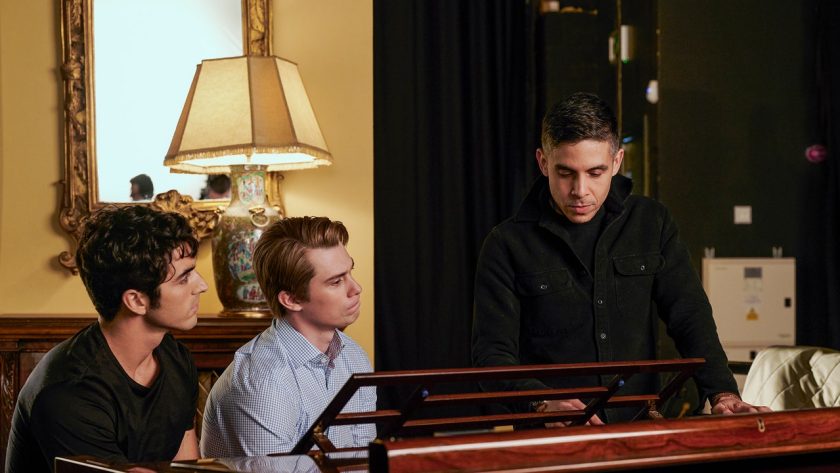“You put the camera on both of them and you let them play,” says Matthew Lopez, director of Red, White and Royal Blue. “In that play, magic happens.”
We’re talking about capturing the chemistry between his leads, Taylor Zakhar Perez and Nicholas Galitzine, the “Netflix summer dudes” that form the core of this summer’s big-screen adaptation of the runaway 2019 bestselling novel by Casey McQuiston that’s landing on Amazon Prime on August 11.
There’s a lot riding on Perez and Galitzine to sell the juicy and puckish premise of the book, in which Alex, the wisecracking son of the president of the United States (Zakhar Perez), goes from playfully despising to playfully hooking up with to playfully falling in love with a capital-P Prince of Wales (played by Galitzine).
Lopez, an acclaimed playwright known for a sweeping six-and-a-half-hour Broadway epic (who also wrote the film’s screenplay with Ted Malawer), says that the chemistry between his leads was so apparent that sometimes he “felt like the schoolmarm trying to get their attention.” Their casual rapport, like the film’s R rating for “language, some sexual content, and partial nudity,” has come as a welcome surprise to the book’s rabid fans, who’ve spent the summer scouring GQ videos and film clips online for evidence of their charm.
Hanging out with GQ on Zoom, Lopez dug into how he discovered that chemistry, the classic romcoms that he returned to for inspiration, and what it’s like releasing a movie during a industry-wide strike.
GQ: What drew you to Red, White & Royal Blue?
Lopez: It was the characters, Alex especially. (As a queer Puerto Rican), I never encountered a character like Alex Claremont-Diaz before, and I’d never read a romantic comedy like this before. It was a new kind of fairy tale. And I am sent a lot of things to read. My agent sent it to me thinking I would want to turn it into a musical and I instantly saw the movie. I was very shameless and harassed (Red, White and Royal Blue producers) Greg Berlanti and Sarah Schechter and told them that I was gonna make this film. Eventually they agreed.
I could feel that this book had the potential to be one of those great romcoms if done right. First and last, a successful romcom has two leads that we believe and root for and care about. It begins and ends with the characters and the actors playing them.
When you think about When Harry Met Sally or Moonstruck, those two characters are so idiosyncratic. In a weird way, actually, Bringing Up Baby is a version of Red White and Royal Blue, which I know is a crazy thing to say. You’ve got Katherine Hepburn, which is the Alex Claremont-Diaz role, a larger-than-life torpedo of a human being. And you’ve got Cary Grant, who plays this buttoned-up stuffed shirt who follows the rules and is always the good boy whose life is upended by this crazy person. The filmmakers in those movies leave the actors on camera together. You’re not cutting back and forth. You put the camera on both of them and you let them play. In that play, magic happens. That spoke to me as a theater artist making his first movie. That means longer takes. That means your actors are learning longer stretches of dialogue more confidently. I brought in Nicholas and Taylor early and we spend weeks rehearsing so when we got on set they could play it like a play. It was my job with Steve Goldblatt, my director of photography, to make sure that it didn’t look like a play.
There’s a lot of exciting and out of the box filmmaking recently by successful playwrights turned first time film directors—think Jeremy O’Harris making Zola, or Celine Song’s Past Lives. Are you all on a group chat about how to break into Hollywood?
I still haven’t figured out how to use WhatsApp, so no. But it’s not surprising that playwrights have an ability to look at storytelling in a different way. There are tremendous game-changing filmmakers whose work I revere who have never set foot inside a theater as a practitioner, but there’s something about training with bodies in space that you’re forced to learn in theater that can age you up as a filmmaker and allow you to understand scenes in a granular way.
Speaking of bodies in space, the movie has what I might call a gratifying sex scene. As a queer person watching a romcom about queer people, it’s nice to see the real thing on screen. How did you think about how to shoot it, what to show, and what you wanted in that moment?
Working with Robbie Taylor Hunt—who’s my amazing intimacy coordinator—and working very carefully and in a very focused way with Taylor and Nick over the course of several days, we found our way in. I needed to make sure that the audience understood what specifically was happening, physically, between these two young men’s bodies while simultaneously communicating what is happening inside their minds and what is happening to them emotionally.



